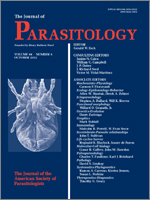Some parasites modify the behavior of intermediate hosts to increase the probability of transmission to the next host in their life cycle. In habitats where this is common, parasites play an important role in predator-prey links and food web dynamics. In this study we used laboratory observations to investigate the behavior of longnose killifish, Fundulus similis, that were naturally infected with metacercariae of the trematode, Euhaplorchis sp. A, from Laguna Madre, south Texas. In particular, we examined whether there was a relationship between the number of metacercariae lodged on the brain of the infected fish and behaviors that made the fish more conspicuous to avian final hosts. We also quantified the abundance and cercariae production of this parasite in its first intermediate snail host, Cerithidea pliculosa, and examined the seasonal variation of Euhaplorchis sp. A in F. similis. Our data demonstrated that Euhaplorchis sp. A affected the surfacing behavior of F. similis in an intensity-dependent manner. Fish with many infections spent longer time at the surface of the water than fish with few infections. Our data also show that Euhaplorchis sp. A is a common parasite in the first intermediate host and produces close to 4,000 cercariae m−2 day−1. Consequently 97% of all fish collected and necropsied were infected, with little seasonal variation in the mean abundance of the parasite. Based on our data, Euhaplorchis sp. A is likely important to predator-prey links in Gulf of Mexico estuary food webs, similar to the closely related Euhaplorchis californiensis in southern California. We expect that other closely related species elsewhere may have similar effects on other fish hosts, emphasizing the need for incorporating trophically transmitted parasites in estuarine food web studies.
How to translate text using browser tools
1 October 2012
Increased Surfacing Behavior In Longnose Killifish Infected by Brain-Encysting Trematode
B. L. Fredensborg,
A. N. Longoria
ACCESS THE FULL ARTICLE

Journal of Parasitology
Vol. 98 • No. 5
October 2012
Vol. 98 • No. 5
October 2012




